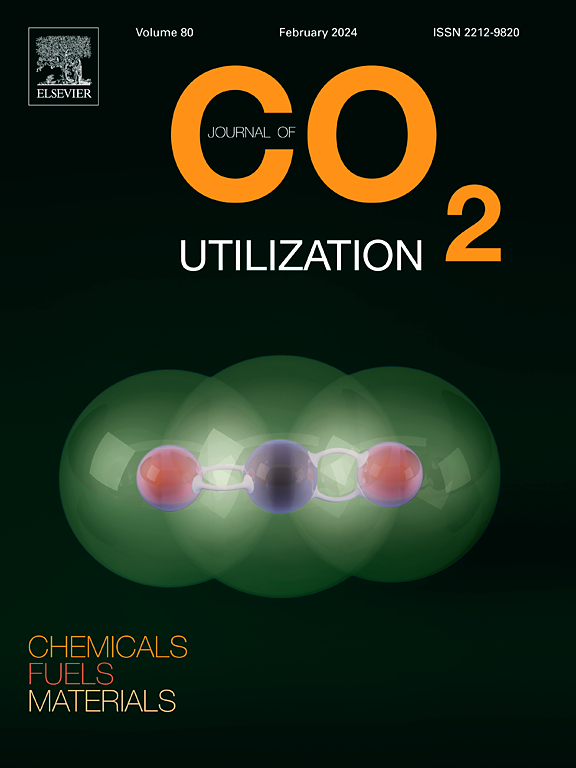在cu基催化剂上进行了声化学二氧化碳还原的范例演示
IF 8.4
2区 工程技术
Q1 CHEMISTRY, MULTIDISCIPLINARY
引用次数: 0
摘要
声化学二氧化碳(CO2)还原是一种很有前途的脱碳技术。然而,固体催化剂在声化学反应器中应用的相关研究很少。在此,我们研究了四种不同的高纳米结构的亚铜氧化物和硫化物,通过超声诱导空化进行声化学CO2还原。具体来说,我们研究了Cu2O立方体、Cu7S4/Cu2O立方体、Cu7S4笼和Cu7S4薄片的形貌。研究发现,每种纳米结构产生的CO和H2的比例在1.0 - 2.3之间。通过对CO2饱和H2O、5 %CO2/ ar饱和H2O、n2饱和H2O、5 %CO2/ n2饱和H2O和CO2饱和KHCO3的测量,系统地研究了不同声学条件对CO2声溶的影响。结果表明,Cu2O立方体在5 %CO2/ ar饱和水中具有最高的CO2-to- co转化率(高达4286.4 μmol·L−1·g−1·h−1)。此外,合成的Cu2O立方体具有良好的声化学稳定性,CO和H2的产率分别稳定在890.3 μmol·L−1·g−1·h−1和966.9 μmol·L−1·g−1·h−1左右。后声化学分析表明,Cu2O立方体保持了较高的CO2-to-CO转化率,其形貌也保持不变。这项工作提供了使用廉价的cu基催化剂实现低碳声化学二氧化碳还原的第一个概念验证演示。本文章由计算机程序翻译,如有差异,请以英文原文为准。
Paradigmatic demonstration of sonochemical carbon dioxide reduction proceeded over Cu-based catalysts
Sonochemical carbon dioxide (CO2) reduction represents a promising decarbonization technology. However, relevant studies regarding the usage of solid catalysts in sonochemical reactor are rare. Herein, we investigate four distinct highly nanostructured cuprous oxides and sulfides for sonochemical CO2 reduction via ultrasound-induced cavitation. Specifically, we investigate Cu2O cubes, Cu7S4/Cu2O cubes, Cu7S4 cages and Cu7S4 sheets morphologies. Each nanostructure is found to produce CO and H2 in various ratios ranging from 1.0 – 2.3. Through a systematic study, we investigate the role of different acoustic conditions on affecting CO2 sonolysis, involving the measurements in CO2-saturated H2O, 5 %CO2/Ar-saturated H2O, N2-saturated H2O, 5 %CO2/N2-saturated H2O and CO2-saturated KHCO3. We show that Cu2O cubes have the highest CO2-to-CO conversion (up to 4286.4 μmol·L−1·g−1·h−1) in 5 %CO2/Ar-saturated H2O. In addition, the as-synthesized Cu2O cubes exhibited promising sonochemical stability, with CO and H2 production rates stabilizing at around 890.3 μmol·L−1·g−1·h−1 and 966.9 μmol·L−1·g−1·h−1, respectively. Post sonochemical analysis indicated that the Cu2O cubes maintain relatively high CO2-to-CO conversion, as well as their morphology. This work provides the first proof-of-concept demonstration of using inexpensive Cu-based catalysts to enable low-carbon sonochemical CO2 reduction.
求助全文
通过发布文献求助,成功后即可免费获取论文全文。
去求助
来源期刊

Journal of CO2 Utilization
CHEMISTRY, MULTIDISCIPLINARY-ENGINEERING, CHEMICAL
CiteScore
13.90
自引率
10.40%
发文量
406
审稿时长
2.8 months
期刊介绍:
The Journal of CO2 Utilization offers a single, multi-disciplinary, scholarly platform for the exchange of novel research in the field of CO2 re-use for scientists and engineers in chemicals, fuels and materials.
The emphasis is on the dissemination of leading-edge research from basic science to the development of new processes, technologies and applications.
The Journal of CO2 Utilization publishes original peer-reviewed research papers, reviews, and short communications, including experimental and theoretical work, and analytical models and simulations.
 求助内容:
求助内容: 应助结果提醒方式:
应助结果提醒方式:


